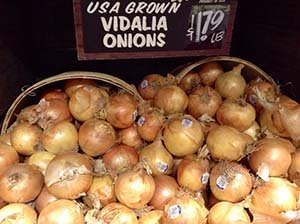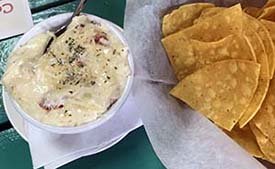Vidalia onion Nutrition facts
Vidalia onion, known for its sweetness and versatility, is much sought after among chefs and home cooks worldwide. This mild-flavored, light-pink onion variety is grown as a specialty crop in the US state of Georgia.
Botanically, vidalia belongs to the same onion (Alliaceae) family, in the genus: Allium.
Scientific name: Allium cepa.
 |
| Vidalia onions. Photo courtesy: Mike Mozart |
Why Vidalia onions are so special?
Vidalia onions have grown with utmost care only in the restricted area around the Altamaha River (confluence of the Oconee River and Ocmulgee River) systems in the South-western part of Georgia State in US.
Least pungent of all the onion subspecies, Vidalia is branded as the "world's sweetest onions." Their mild flavor is because of the low sulfur content in the soil, combined with the unique climate conditions found in its production area.
10 Amazing Health Benefits of Vidalia Onions
Vidalia onions carry fewer calories than red onions. While 100 g fresh Vidalia has just 32 calories, red onions hold 40 calories.
Unlike other onion varieties, vidalia contains small amounts of Allium and Allyl disulfide. These phytochemical compounds, which give a pungent character to onions, convert into allicin when subjected to distortion (crushing, cutting, etc) through an enzymatic reaction.
Research studies found that these compounds possess anti-mutagenic (protection from cancers) and anti-diabetic properties (help lower blood sugar levels in diabetics).
Moreover, allicin has cholesterol-controlling properties. It inhibits HMG-CoA reductase, the cholesterol-producing enzyme in the liver cells. Further, it was also found to have antibacterial, antiviral, and anti-fungal activities.
Allicin also brings down blood vessel stiffness through the facilitation of nitric oxide (NO) release in their walls, thereby reducing the total blood pressure. Further, it prevents platelet clot formation in the blood vessels and thereby, helps reduce the overall risk of stroke, coronary artery disease (CAD), and peripheral vascular diseases (PVD).
Onions, including vidalia, are a rich source of chromium, a trace mineral that helps tissue cells respond appropriately to insulin levels in the blood. It thus helps regulate insulin action and control sugar levels in diabetes.
Vidalia hold slightly less amounts of flavonoid antioxidant quercetin than red onions. Quercetin is found to have anti-carcinogenic, anti-inflammatory, and antidiabetic functions.
Vidalia hold more folates (23μg) than red onions (19μg). It is also a moderate source of other B-complex groups of vitamins like pantothenic acid, pyridoxine, riboflavin, and thiamin. Pyridoxine (vitamin B-6) helps in the relief of neurotic conditions through increasing GABA levels in the brain.
It is also a modest source of minerals like calcium, phosphorus, manganese, and zinc. Manganese acts as a co-factor for the antioxidant enzyme, superoxide dismutase.
Further, isothiocyanate antioxidants in them help provide relief from colds and flu by exerting anti-inflammatory actions.
Vidalia onion facts
Vidalia onion is the official state vegetable of Georgia.
Its designated growing region is regulated by the Georgia Department of Agriculture and is limited to 20 odd counties in the Southeast part of the state.
The crop is protected by Federal Marketing Order #955.
Vidalia Onions contain higher water and sugar content than other onion varieties.
Vidalia's sulfur content is very low; hence they are sweet in taste and unusually less pungent than any other onion varieties.
Cultivation and harvesting
Vidalia requires mild winters, shorter day-times, and adequate moisture in the soil to flourish.
Completely grown bulbs are ready for harvesting from early spring through mid-June. Harvesting is usually done by hand, considering the delicate nature of Vidalia onions. Later, they dried thoroughly, graded, and packed before dispatching to customers.
| Principle | Nutrient Value | Percent of RDA |
|---|---|---|
| Energy | 32 Kcal | 1.6% |
| Carbohydrates | 7.55 g | 7% |
| Protein | 0.80 g | 1.5% |
| Total Fat | 0.08 g | 0.5% |
| Cholesterol | 0 mg | 0% |
| Dietary Fiber | 0.9 g | 2.25% |
| Vitamins | ||
| Folates | 23 µg | 6% |
| Niacin | 0.133 mg | 1% |
| Pantothenic acid | 0.098 mg | 2% |
| Pyridoxine | 0.130 mg | 10% |
| Riboflavin | 0.020 mg | 1.7% |
| Thiamin | 0.041 mg | 3.5% |
| Vitamin-A | 1 IU | <1% |
| Vitamin-C | 4.8 mg | 8% |
| Vitamin-E | 0.02 mg | 0% |
| Electrolytes | ||
| Sodium | 8 mg | 0.5% |
| Potassium | 119 mg | 2.5% |
| Minerals | ||
| Calcium | 20 mg | 2% |
| Copper | 0.056 mg | 6% |
| Iron | 0.26 mg | 3% |
| Magnesium | 9 mg | 2.25% |
| Manganese | 0.076 mg | 3% |
| Phosphorus | 27 mg | 4% |
| Zinc | 0.13 mg | 1% |
Selection and storage
Fresh Vidalia Onions can be available through mid-July in grocery stores and supermarkets in the US. Thanks to the large-scale availability of controlled atmosphere storage facilities, Vidalia Onions are now available through December.
Buy uniform, medium-sized onions. Avoid any sprouts, blotched, and soft ones.
Unlike other variety onions which can be kept in a cool, dark place, Vidalia needs refrigeration because of its high moisture content. Wrap them in paper towels and store them in a separate section away from other vegetables. If stored well, they last for many weeks.
Preparation and serving methods
Vidalia onions are so sweet and mild; you can eat them raw in salads. They are what sweet peppers in otherwise dominant hot peppers in chili family.
Vidalia brings delightful flavor to the recipes. Their preparation techniques are the same as other onion varieties. Trim either end using a sharp knife. Remove the outer 2-3 layers of skin until you find a fresh, thick white bulb. You can slice for rings or chop them into fine cubes depending upon the recipes.
 |
| Vidalia cheese dip and chips.
Photo courtesy: Tam warner |
Here are some serving tips:
Vidalia instantly appeals to those who like mild onion flavor and sweetness in recipes. They can be eaten raw, roasted, or fried to enjoy these mild Georgian onions.
Vidalia found use in almost any food, be it raw salads, appetizers, sauces, vinaigrette, dips, and main courses.
Chefs prefer them in classic Mediterranean dishes, especially in pizzas, burgers, soups, tart, quiche, stuffing, etc.
Finely chopped vidalia complements well in stews, gravies, sauces, etc., particularly with fish.
They make excellent pickling.
Safety profile
Unlike red onions, the mild nature of Vidalia onions causes less irritation to mucosa and eyes. Vidalia contains less allyl sulfide gas while chopping or slicing them. Allyl sulfide is concentrated at the ends, especially near its bottom root system.
Soak the trimmed bulb in cold water for a few minutes before you chop or slice it to minimize mucosal irritation. (Disclaimer).
You may also like to read≻≻-
Shallots nutrition facts and health benefits.
Spring onion nutrition facts and health benefits.
Leeks nutrition facts and health benefits.
≺≺ Back to Vegetables from Vidalia onion nutrition. Visit here for an impressive list of vegetables with complete illustrations of their nutrition facts and health benefits.
≺≺ Back to Home page.
Further reading:
Stanford School of Medicine Cancer information Page- Nutrition to Reduce Cancer Risk (Link opens in new window).